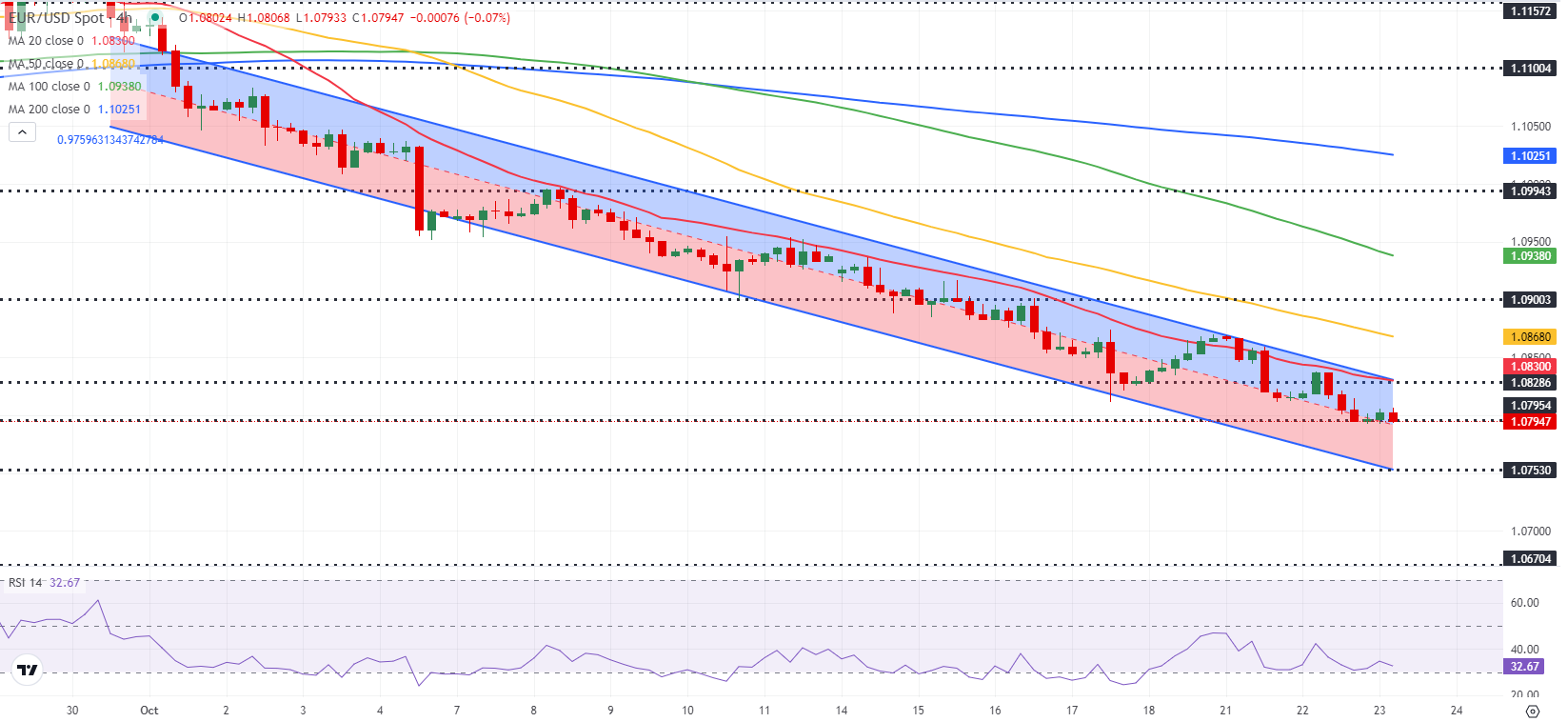- EUR/USD trades in a tight channel near 1.0800 after posting small losses on Tuesday.
- The next technical support for the pair could be seen at 1.0750.
- ECB President Lagarde will speak on the European economic outlook.
EUR/USD registered small losses on Tuesday as the US Dollar (USD) preserved its strength in the absence of high-tier data releases. The pair was last seen fluctuating near 1.0800. Once this level is confirmed as resistance, technical sellers could look to retain control of the pair's action.
Euro PRICE This week
The table below shows the percentage change of Euro (EUR) against listed major currencies this week. Euro was the weakest against the US Dollar.
| USD | EUR | GBP | JPY | CAD | AUD | NZD | CHF | |
|---|---|---|---|---|---|---|---|---|
| USD | 0.66% | 0.60% | 1.83% | 0.08% | 0.62% | 0.58% | 0.39% | |
| EUR | -0.66% | -0.13% | 1.07% | -0.52% | -0.07% | -0.19% | -0.35% | |
| GBP | -0.60% | 0.13% | 1.21% | -0.52% | 0.04% | -0.02% | -0.26% | |
| JPY | -1.83% | -1.07% | -1.21% | -1.74% | -1.20% | -1.19% | -1.48% | |
| CAD | -0.08% | 0.52% | 0.52% | 1.74% | 0.45% | 0.56% | 0.18% | |
| AUD | -0.62% | 0.07% | -0.04% | 1.20% | -0.45% | 0.03% | -0.30% | |
| NZD | -0.58% | 0.19% | 0.02% | 1.19% | -0.56% | -0.03% | -0.24% | |
| CHF | -0.39% | 0.35% | 0.26% | 1.48% | -0.18% | 0.30% | 0.24% |
The heat map shows percentage changes of major currencies against each other. The base currency is picked from the left column, while the quote currency is picked from the top row. For example, if you pick the Euro from the left column and move along the horizontal line to the US Dollar, the percentage change displayed in the box will represent EUR (base)/USD (quote).
The cautious market mood helped the USD hold its ground on Tuesday and didn't allow EUR/USD to stage a rebound. Meanwhile, European Central Bank (ECB) President Christine Lagarde's comments did little to nothing to help the Euro find demand.
In an exclusive interview with Bloomberg TV's Francine Lacqua on Tuesday, Lagarde said that inflation numbers in the Eurozone are "relatively reassuring" but added that they can't jump to a conclusion that it's a done deal. She further noted that she hopes that inflation will be back at their target sooner than projected.
Lagarde will speak again on Wednesday, this time discussing the European economic outlook at the 2024 Annual Meetings of the International Monetary Fund (IMF) and the World Bank Group (WBG). In case Lagarde acknowledges the worsening growth prospects, the Euro could have a hard time attracting investors.
The US economic calendar will feature Existing Home Sales data for September, which is unlikely to trigger a noticeable market reaction. Later in the day, the Federal Reserve (Fed) will publish its Beige Book.
EUR/USD Technical Analysis
EUR/USD remains within the descending regression channel coming from late September and the Relative Strength Index (RSI) indicator on the 4-hour chart stays between 30 and 40, suggesting that the pair has more room on the downside before turning technically oversold.
The mid-point of the descending channel aligns as a pivot level at 1.0800. Once this level is confirmed as resistance, the lower limit of the channel at 1.0750 could be seen as the next bearish target ahead of 1.0670 (static level from June).
On the upside, 1.0830 (20-period Simple Moving Average (SMA), upper limit of the descending channel) could be seen as first resistance before 1.0870 (50-period SMA) and 1.0900 (static level, round level).
Euro FAQs
The Euro is the currency for the 19 European Union countries that belong to the Eurozone. It is the second most heavily traded currency in the world behind the US Dollar. In 2022, it accounted for 31% of all foreign exchange transactions, with an average daily turnover of over $2.2 trillion a day. EUR/USD is the most heavily traded currency pair in the world, accounting for an estimated 30% off all transactions, followed by EUR/JPY (4%), EUR/GBP (3%) and EUR/AUD (2%).
The European Central Bank (ECB) in Frankfurt, Germany, is the reserve bank for the Eurozone. The ECB sets interest rates and manages monetary policy. The ECB’s primary mandate is to maintain price stability, which means either controlling inflation or stimulating growth. Its primary tool is the raising or lowering of interest rates. Relatively high interest rates – or the expectation of higher rates – will usually benefit the Euro and vice versa. The ECB Governing Council makes monetary policy decisions at meetings held eight times a year. Decisions are made by heads of the Eurozone national banks and six permanent members, including the President of the ECB, Christine Lagarde.
Eurozone inflation data, measured by the Harmonized Index of Consumer Prices (HICP), is an important econometric for the Euro. If inflation rises more than expected, especially if above the ECB’s 2% target, it obliges the ECB to raise interest rates to bring it back under control. Relatively high interest rates compared to its counterparts will usually benefit the Euro, as it makes the region more attractive as a place for global investors to park their money.
Data releases gauge the health of the economy and can impact on the Euro. Indicators such as GDP, Manufacturing and Services PMIs, employment, and consumer sentiment surveys can all influence the direction of the single currency. A strong economy is good for the Euro. Not only does it attract more foreign investment but it may encourage the ECB to put up interest rates, which will directly strengthen the Euro. Otherwise, if economic data is weak, the Euro is likely to fall. Economic data for the four largest economies in the euro area (Germany, France, Italy and Spain) are especially significant, as they account for 75% of the Eurozone’s economy.
Another significant data release for the Euro is the Trade Balance. This indicator measures the difference between what a country earns from its exports and what it spends on imports over a given period. If a country produces highly sought after exports then its currency will gain in value purely from the extra demand created from foreign buyers seeking to purchase these goods. Therefore, a positive net Trade Balance strengthens a currency and vice versa for a negative balance.
Information on these pages contains forward-looking statements that involve risks and uncertainties. Markets and instruments profiled on this page are for informational purposes only and should not in any way come across as a recommendation to buy or sell in these assets. You should do your own thorough research before making any investment decisions. FXStreet does not in any way guarantee that this information is free from mistakes, errors, or material misstatements. It also does not guarantee that this information is of a timely nature. Investing in Open Markets involves a great deal of risk, including the loss of all or a portion of your investment, as well as emotional distress. All risks, losses and costs associated with investing, including total loss of principal, are your responsibility. The views and opinions expressed in this article are those of the authors and do not necessarily reflect the official policy or position of FXStreet nor its advertisers. The author will not be held responsible for information that is found at the end of links posted on this page.
If not otherwise explicitly mentioned in the body of the article, at the time of writing, the author has no position in any stock mentioned in this article and no business relationship with any company mentioned. The author has not received compensation for writing this article, other than from FXStreet.
FXStreet and the author do not provide personalized recommendations. The author makes no representations as to the accuracy, completeness, or suitability of this information. FXStreet and the author will not be liable for any errors, omissions or any losses, injuries or damages arising from this information and its display or use. Errors and omissions excepted.
The author and FXStreet are not registered investment advisors and nothing in this article is intended to be investment advice.
Recommended Content
Editors’ Picks

EUR/USD stays directed toward 1.1000 amid intense US Dollar selling
EUR/USD is consolidating the uptick to near 1.1000 in the European session on Thursday. The pair benefits from US President Trump's tariffs-led intense US Dollar weakness. However, further upside appears capped due to escalating trade war fears, with looming EU retaliatory tariffs.

GBP/USD jumps above 1.3100 ahead of US data
GBP/USD is extending its upbeat momentum above 1.3100 in European trading on Thursday as the US Dollar slumps to a fresh YTD low. Worries about a tariff-driven US economic slowdown lift Fed rate cut bets and weigh on the Greenback. The focus now remains on the US data for further impetus.

Gold price moves further away from all-time peak; downside potential seems limited
Gold price extends its steady intraday pullback from the all-time peak touched this Thursday, though it manages to hold above the $3,100 mark through the early European session. Bullish traders opt to take some profits off the table and lighten their bets around the commodity amid slightly overbought conditions.

Bitcoin price reacts as Gold sets fresh record highs after Trump’s reciprocal tariffs announcement
Bitcoin price plunges towards $82,000 as Gold soars past $3,150 after US President Donald Trump imposed new tariffs on Israel and UK, triggering global markets turbulence.

Trump’s “Liberation Day” tariffs on the way
United States (US) President Donald Trump’s self-styled “Liberation Day” has finally arrived. After four straight failures to kick off Donald Trump’s “day one” tariffs that were supposed to be implemented when President Trump assumed office 72 days ago, Trump’s team is slated to finally unveil a sweeping, lopsided package of “reciprocal” tariffs.

The Best brokers to trade EUR/USD
SPONSORED Discover the top brokers for trading EUR/USD in 2025. Our list features brokers with competitive spreads, fast execution, and powerful platforms. Whether you're a beginner or an expert, find the right partner to navigate the dynamic Forex market.
